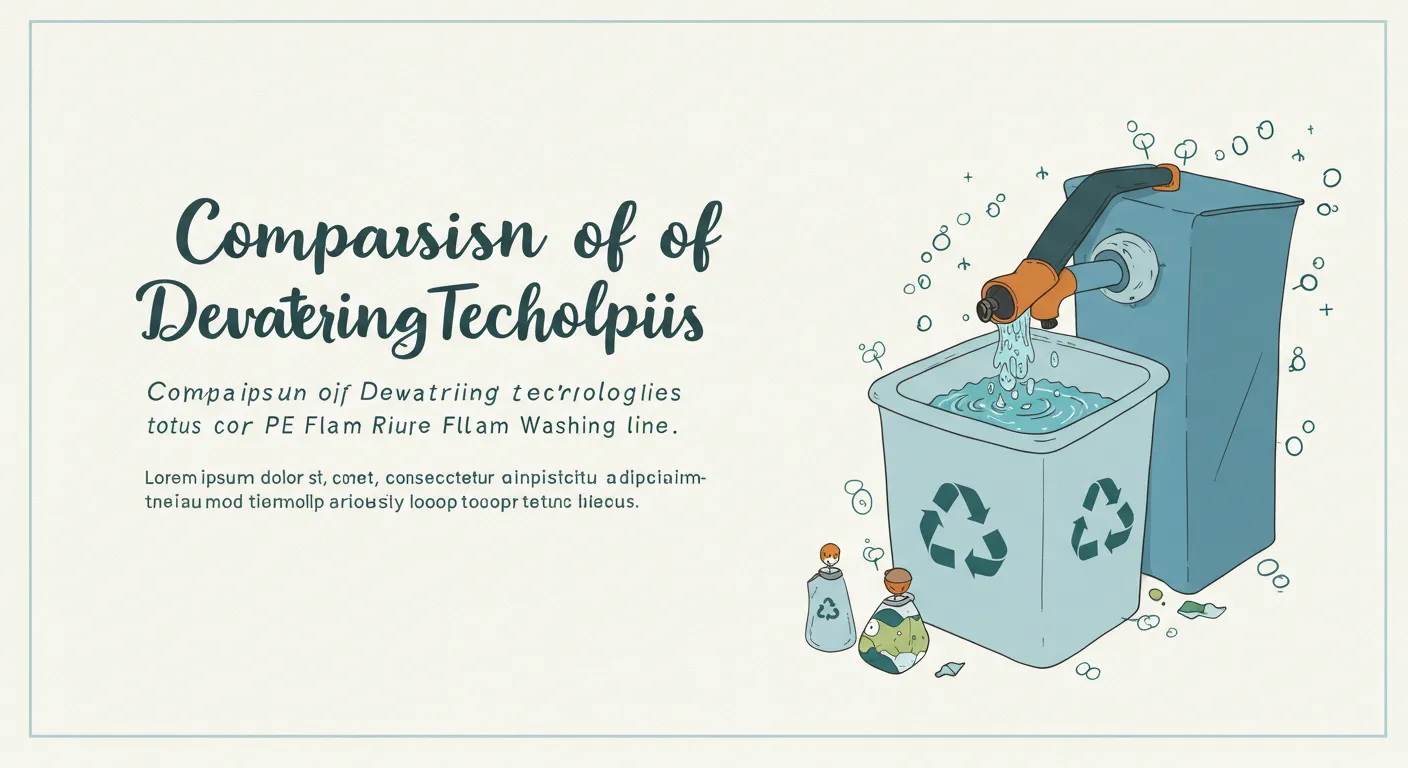Introduction: Why Dewatering Matters in PE Film Recycling
Recycling post-consumer polyethylene (PE) film is essential for reducing plastic waste and supporting a sustainable, circular economy. One of the most critical steps in a PE film washing line is dewatering, a process that removes excess water from washed film flakes before pelletizing. Effective dewatering directly influences recycled PE quality, energy consumption, and recycling profitability.
Insufficient dewatering can cause several problems:
- Higher energy use: Wet films increase drying and melting energy needs.
- Quality issues: Excess moisture leads to defective recycled pellets with lower mechanical properties.
- Operational disruptions: Wet material may clog downstream equipment.
This article compares three leading dewatering methods—centrifugal dewatering, squeezing, and pipe hot air drying—to help you choose the best technology for your recycling operation.
1. Centrifugal Dewatering: High-Speed Moisture Removal
Centrifugal dewatering uses rapid rotation to generate centrifugal force, quickly removing the bulk of water from wet PE flakes.
How It Works:
- Wet film flakes enter a rotating shaft with paddles spinning around 1000 RPM.
- The flakes hit a mesh screen, expelling water through the screen perforations.
- Water collects for recycling or disposal, leaving flakes partially dried.
Advantages:
- High throughput: Processes 300–2000 kg/h.
- Significant bulk water removal: Moisture reduced to about 20–30%.
- Low operational costs compared to thermal drying.
- Simple maintenance and operation.
Limitations:
- Achieves moisture levels of only about 3–12%; extrusion ideally requires below 1%.
- Flexible PE films retain more moisture due to their surface area and complex structure.
Practical Considerations:
- Match machine capacity with washing line throughput.
- Regular cleaning, lubrication, and maintenance are essential to optimal performance.
2. Squeezing Technology: Enhanced Dewatering with Mechanical Pressure
Squeezing technology applies direct mechanical pressure to extract moisture, providing superior drying compared to centrifugal methods.
Types of Squeezers:
Screw Press Dewatering:
- Rotating screw compresses film against a cylindrical perforated barrel.
- Moisture reduction can reach below 3%, even as low as 1–3%.
- Volume reduction helps efficiency and pellet quality.
- Low to moderate energy consumption, sometimes eliminating thermal drying stages.
Roller Squeezers:
- Films pass between rollers exerting gentle pressure.
- Suitable for delicate films, though less effective than screw presses.
Air Blower and Vacuum Squeezers:
- Air blower gently removes water but is less efficient.
- Vacuum squeezers use suction for effective drying but require higher investment and maintenance.
Advantages:
- Achieves very low moisture content, significantly improving pellet quality.
- Potential to replace centrifugal and thermal drying stages.
- Reduces recycled material volume.
Limitations:
- Higher initial investment, especially for screw presses.
- Requires regular maintenance and sometimes pre-shredding of film.
3. Pipe Hot Air Drying: Precision Drying for Optimal Quality
Pipe hot air drying thermally eliminates residual moisture, crucial for achieving ultra-low moisture levels required for high-quality recycled pellets.
How It Works:
- Clean film flakes travel through heated stainless steel pipes.
- Hot air evaporates residual moisture, resulting in final moisture levels below 3%, often less than 1%.
- A cyclone separator cools and removes fine dust from dried flakes.
Advantages:
- Best method for achieving extremely low moisture content.
- Suitable for high-quality pellet production, including food-grade applications.
Limitations:
- High energy consumption due to heating requirements.
- Risk of thermal degradation if not properly controlled.
- Requires significant facility space.
Practical Considerations:
- Adequate pipe insulation reduces energy loss.
- Regular maintenance of heaters and blowers is necessary.
Comparative Analysis: Choosing the Right Dewatering Method
| Parameter | Centrifugal Dewatering | Squeezing Technology | Pipe Hot Air Drying |
|---|---|---|---|
| Initial Investment Cost | Moderate | Moderate to High | Moderate to High |
| Operating Costs | Low to Moderate | Low to Moderate | High |
| Energy Consumption | Lower | Lower | Higher |
| Final Moisture Level | ~20–30% | Often <3%, down to ~1% | Typically <3%, often <1% |
| Throughput Capacity | High | Moderate to High | High |
| Maintenance Requirements | Simple | Moderate | Moderate |
| Space Requirements | Moderate | Moderate | Moderate to High |
| Complexity | Simple | Moderate | Moderate |
| Suitability | Initial bulk drying | Enhanced drying | Final precision drying |
Key Factors to Consider
When selecting your dewatering technology, evaluate these critical aspects:
- Operation Scale: Choose based on processing volume and throughput requirements.
- Moisture Requirements: Decide how dry your flakes must be for pelletizing.
- Budget Constraints: Balance initial investment and operational efficiency.
- Energy Efficiency Goals: Prioritize lower-energy mechanical methods where possible.
- Input Material: Account for film type, contamination, and thickness.
- Facility Space: Assess space availability for equipment setup.
Conclusion: Building Your Optimal Dewatering Strategy
Each technology offers distinct advantages:
- Centrifugal Dewatering efficiently handles initial bulk moisture removal.
- Squeezing Technology significantly reduces moisture with moderate energy usage.
- Pipe Hot Air Drying achieves optimal dryness for high-quality recycled pellets but requires higher energy input.
For most recycling operations, combining these methods strategically maximizes efficiency and cost-effectiveness. For instance, use centrifugal dewatering initially, followed by squeezing or pipe drying based on specific moisture targets. Carefully considering your operational needs will ensure you implement the best dewatering strategy, maximizing recycled PE quality and profitability.


